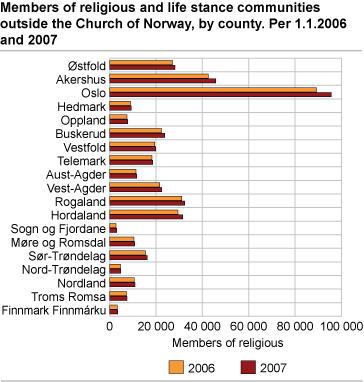Content
Published:
This is an archived release.
Membership figures reached 400 000
The membership figures of religious and life stance communities outside the Church of Norway exceeded 400 000 for the first time in 2007. 8.6 per cent of the population were members of communities that receive state subsidies.
404 000 people were members of religious and life stance communities outside the Church of Norway in January 2007, an increase of 20 000 compared with the previous year. More than half, or 226 000, were members of Christian communities. Furthermore, 79 700 were members of life stance communities and accounted for approximately 20 per cent of all members of communities outside the Church of Norway. The Norwegian Humanist Association was the largest life stance community with 78 900 members. Furthermore, various Islamic communities accounted for around 20 per cent of the members, while Buddhist, Hindu and Sikh communities accounted for 3 per cent, 1 per cent and 0.6 per cent of members respectively.
|
The statistics are based on annual applications for central government subsidies submitted by religious and life stance communities to the county governor. The membership lists are sent electronically to the Brønnøysund Register Centre via the county governor for control and elimination of duplicates. As of 2005, the statistics are not comparable with previous years since the basis for the data has been changed. |
Tables:
- Table 1 Members of religious and life stance communities outside the Church of Norway, by religion/life stance. Per 1.1. 2005- 2007. Numbers and per cent
- Table 2 Members of religious and life stance communities outside the Church of Norway. Religion/life stance. County. 2006-2007
- Table 3 Members of Christian communities outside the Church of Norway. Per 1.1.2005-2007
Additional information
The statistics include members of religious and life stance communities based on annual applications for central government subsidies. Some communities do not apply for subsidies every year. Due to this fact, the number of members in some categories varies some years. Some communities never apply for subsidies.
Contact
-
Andreas Østhus
E-mail: andreas.osthus@ssb.no
tel.: (+47) 47 64 99 08
-
Andrea Ihler Evensen
E-mail: andreaihler.evensen@ssb.no
tel.: (+47) 93 06 06 87

